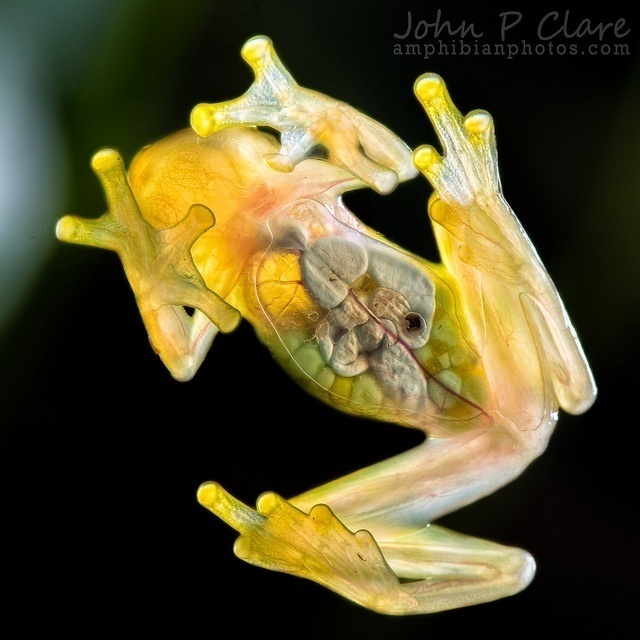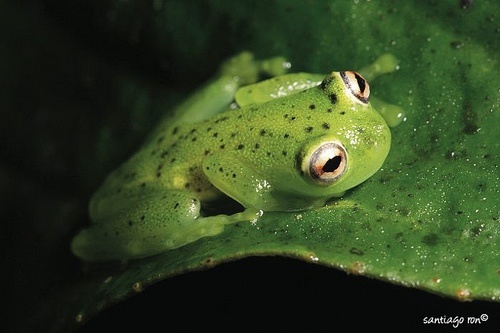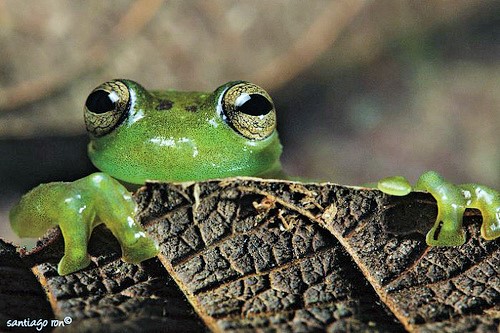G is for Glass Frog Facts
Glass frogs are so named because of their translucent abdominal skin. They belong to the Centrolenidae family of amphibians and are found in humid rain forests throughout Central and South America including Belize, Costa Rica, Colombia, Guatemala, Honduras, Mexico and Panama. To date, thirteen species of cloud frogs have been identified in Costa Rica.

Glass Frog Facts – Anatomy
- Glass frogs are generally small, ranging from 1.2 to 3.0 (3 to 7.5 cm) in length.
- They are typically a soft lime-green color, with yellow suction pads on its fingers and toes.
- They have very unique eyes, which are forward-facing. The irises are gold.
- The most unique feature of the glass frog is its transparent underbelly, which reveals a fully visible system of organs, including the liver, full intestinal tract, and heart, which one can actually see beating. In females, one can see eggs when they are gravid.
Take a look at this short but fascinating video.
Glass Frogs Facts – Habitat
- Glass frogs live almost exclusively in the humid rain forest trees of Central and South America. They can sometimes be found on low hanging branches near or around running water where it lays its eggs.
- The glass frog is a nocturnal creature. During the day it sleeps in thick forest vegetation. They actively spend their evenings searching for food. Night and early morning is their most active time for breeding.

Glass Frog Facts – Mating
- Glass frogs live along rivers and streams during the breeding season.
- Male glass frogs are territorial and will not allow another male on its turf, chasing them away if they dare to try. The males have a distinctive mating call which increases in volume as they age or become more dominant.
- The female lays a clutch of 18 to 30 eggs on the underside of leaves or branches hanging over streams, creeks or small rivers.
- Males stand guard over the eggs to protect them from predators and keep them moist. When the eggs hatch, the tadpoles drop into the stream or river below, where they develop into frogs.
Glass Frog Facts – Diet
- Glass frogs have a diet consisting of flies, spiders and other small invertebrates.
Glass Frog Facts – Threats
- Although the glass frog is one of the more abundant species found in Central and South America, habitat loss from deforestation and human activity is a threat.

Sources for Glass Frog Facts: Fact Zoo.com, Rainforest Alliance.org, and Wikipedia
Video is by JP Lawrence
G is for Glass #Frog Facts : A-Z Collection of Cool Animals #frogs Click To Tweet
***
I hope you have enjoyed, “G is for Glass Frog Facts“
You might also enjoy, “Indian Dancing Frogs, Dancing Their Way to Extinction“
*
Don’t miss out on any A-Z challenge posts!
**A-Z Collection of Cool Animals April Challenge: MASTER LIST**
*
A QUESTION FOR YOU:
Tell me what animals you would like to learn more about.
Do you have a story you’d like to share?
*** Leave your comment below. ***
(It’s just sexy!)

Thank you for taking the time to visit my blog!
PEACE
*
Disclosure: Animal Bliss is an affiliate of Natural Wonder Products and will earn a (very small) commission from purchases made through links on this website.
(Coffee money – thank you!)
😀
PLEASE SHARE – Thanks!
- Mindful Travel With Your Dog This Holiday Season - December 23, 2019
- A-Z of Australia’s Endangered Wildlife - December 20, 2019
- Teaching Your Kids How to Walk the Dog Safely - December 2, 2019


That is so amazing! When I saw the photo I wanted to know more about this frog. That transparent underbelly is so interesting.
Isn’t it, though? I couldn’t resist writing about it once I saw the image. I just love sharing something like this with my readers. I’m so glad you stopped to visit my blog today, Mary. I truly appreciate you. 🙂
Interesting that you can see all the frogs internal organs. Thanks for the great information.
You’re quite welcome, Sandy. Thank you for stopping by! 🙂
What beautiful and amazing creatures! The video where you could actually see the frog’s heart beating was stunning. You have a beautiful and fascinating blog. Happy A-to-Z blogging!
I’m glad you enjoyed and appreciated the glass frog, Jeannette. 🙂 Yes, the beating heart is amazing, isn’t it? Wow. Thank you so much for visiting, and you have fun too with the A-Z Challenge. It’s keeping us on her toes, is it not? I’ll go check out your post about grooming your dog at home now. Peace.
Fascinating! Are they the only creatures with a translucent underbelly? Imagine if people were like that. A species of people whose entire organ system was visible through translucent skin. Sounds ikky, but would make for an interesting sci-fi story… 🙂
If humans had this features, I’m afraid it wouldn’t be as pretty to look at as the Glass Frog’s. Know what I mean? Eww. Not with all the junk food we tend to eat. lol Thanks for much for visiting my blog today, Colin, and for reading my post. I do hope you’ll come back soon! Take care! 🙂
Just the sound on that video is wonderful to hear. What an incredibly beautiful animal. Thank you for showing!
Thanks, Katy. I’m so glad you enjoyed it. Thanks for visiting! 🙂
The glass frogs are amazing creatures. I’ve never seen them before.
Aren’t they amazing? Nature is incredible. Wow. I’m glad you stopped by, Sharon. Thank you for your comment too! Come back soon!
Oh my gosh what an wonderful frog
Isn’t it interesting? Wow. Nature sure is fascinating. Thank you for visiting my blog today, Dianna. I always appreciate it when you do. Peace. 🙂
Sadly many are now extinct. I have a poem for it!
You have a poem for the glass frog? My, we really are on the same wavelength, aren’t we, Liz? Cool. Off to visit your G is for Gorilla post now. Can’t wait. 🙂